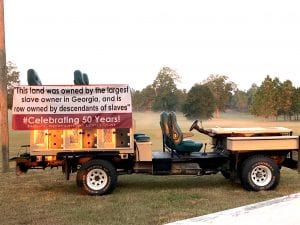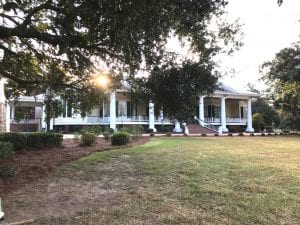
Sign greeting visitors to Resora at Cypress Pond farm during the New Communities 50th Anniversary celebration Oct. 2-5, 2019. Photo credit: Miriam Axel-Lute
“This land once belonged to the largest slaveholder in Georgia, and is now owned by descendants of slaves.” The sign hung on a piece of farm equipment by the gate to a 1600-acre pecan farm in Albany, Georgia, known as Resora.
Though Resora was only purchased by the Charles Sherrod Community Development Corporation in 2011, the sign had been posted to to celebrate the 50th anniversary of the launching of New Communities, Inc., the first community land trust in the United States. Many of the visitors arriving for the celebration (myself included) felt like pilgrims coming to a holy place.
The story of how the path of the organizers led from New Communities to Resora is a quintessentially American one. It’s best told in the documentary Arc of Justice, but the quick summary is this: Distressed by stories of African-American sharecroppers being kicked out of their homes after participating in their voter registration drives, a group of civil rights activists led by Charles and Shirley Sherrod began to study collective land ownership, and raised money to purchase a 6,000 acre parcel. From 1969 to 1985, 500 families operated the land as a community land trust, with a successful farm and market on site. They were actively planning to develop small villages for collective housing as well, though accessing financing was difficult. The community was seen as a threat to the white supremacist power structure and suffered, but survived, many attacks of vandalism and sabotage.
Then in the early 1980s came a drought. Like all other affected farmers, New Communities applied to the USDA for a loan to carry them through. Like many other Black farmers, they were denied. In 1985, New Communities lost their land to foreclosure, adding to the pattern of Black land loss across the country. They joined the Black farmers’ collective lawsuit against the USDA in 1997, and in 2007 were awarded $12 million in damages. That money enabled them to revive the organization and purchase the former plantation that is now Resora.
I dare you to watch Arc of Justice and not choke up. I know for a fact I’m not the only one who does every time. So it was meaningful and appropriate that a subset of those attending the Center for Community Progress and Grounded Solutions joint conference in Atlanta last week took a side trip down to Albany to participate in some of the New Communities 50th anniversary observance.
There are so many things we can learn from New Communities—lessons about perseverance, the importance of land, lengths the white power structure will go when it feels threatened by Black self-determination, and the role Black land loss, and theft, has played in the country’s history.

The “ante-bellum” mansion at Resora farm, once home to one of Georgia’s largest slaveowners. The building first made New Communities founder Shirley Sherrod uncomfortable enough that she didn’t think the property was the right choice for them, before she decided that taking ownership of it would be a powerful healing statement.
But one particular thing stuck out to me: The way that the story of New Communities illustrates how the experience of racial discrimination and oppression can develop into a heightened ability to see and name problems with the status quo and pursue new and unheard of strategies and approaches. As Lisa Mensah, director of the Opportunity Finance Network said in our community development CEOs of color roundtable last spring, “I think starting out life as a minority makes you very capable of taking on the fight. Personally, I don’t start from a position of thinking that the status quo is good or is impervious to change.”
This is neither automatic nor exclusive (others were also questioning patterns of land ownership in the 1960s, for example). But it’s also, I think, no accident that Dr. Martin Luther King linked civil rights to unusually strong anti-war and anti-poverty stances. And it was no accident that it was a group of people who had experienced some of the worst abuses of the land ownership system in this country who made the first groundbreaking attempt to realize a different approach.
On a much smaller scale, but what set me thinking in this direction, was the hypothesis that randolph carr III, field organizer for the National Black Food and Justice Alliance, floated in a workshop on urban gardening at Resora Saturday morning. Urban gardening and agriculture, he posited, could be a route to bridging urban and rural cultural divides, providing a common ground on which to meet. While I find this an interesting and promising idea on its own, it also struck me that even throughout planning for our recent rural focus issue, bridging urban and rural was mostly not a thing anyone considered possible enough to name as a goal. With our feet on the dirt of New Communities, however, it seemed like such things were well within the range of what we should be seriously discussing.
Earlier that week in Atlanta, at the Reclaiming Vacant Properties conference, there was a plenary session with five relatively new CEOs of color leading national organizations in the community development field. The panelists spoke, as they did in our roundtable, about the importance of bringing cultural literacy and lived experience to their work, which made them able to better understand needs, dynamics, and appropriate solutions.
But in addition, Dr. Akilah Watkins-Butler, the director of Center for Community Progress, spoke about how the cohort of leaders on the stage, because of their shared experiences and positions, had been intentionally collaborating with each other in a funding and institutional environment that could easily lead to a defensive and inward-looking stance. Instead, Watkins-Butler described, they are working hard to stay connected, vulnerable, and honest with each other to provide support and also accountability. “It’s scary,” she admitted. “We could easily be competitors.”
Along with all the other benefits, and the fact that it’s just time our leaders reflected our communities better, Watkins-Butler’s comments made me wonder if the demographic shift in the leadership of so many key national organizations may also have a ripple effect of ushering in a new era of cooperation and unity of purpose throughout the field. Even though their cohort is somewhat uniquely positioned because they all took top positions at previously white-led organizations around the same time, I hope the type of working relationships they model can spread beyond their circle to other organizations within the field.
It’s easy to hem in our vision based on what seems palatable or incrementally possible. Sometimes it takes folks who have been repeatedly left out of those limited visions to shake us into remembering to aim big, consider new strategies, and leave no one behind.






Thank you SO much for such an intriguing, encouraging article! Only last week, I completed reading an article out of the September 2019 issue of the Atlantic Monthly, “The Great Land Robbery: This Land Was Our land.” Not only did this article expose to me the atrocities of Jim Crow policies and dis-empowerment of voting rights for descendants of African-American Slaves; it gave me the encouragement to continue with my efforts to re-commit and develop our Bone-Crutcher Family Heritage Foundation, established in 2017 to recognize and memorialize our historic legacy through the efforts of my Great-Grandfather and Great-Grandmother, David and Lucy Crutcher. The Jude-Crutcher Home has been a Historical Landmark since 2012, and has been written about in National Historical Landmark documents and magazines over the years. Google it to find out more about our history and fore family in the Huntsville, AL Vicinity of Madison County, AL.
Thanks again for your exposure and grit seeking justice for our African American Rural Communities!
Michael F. King
Chicago, IL